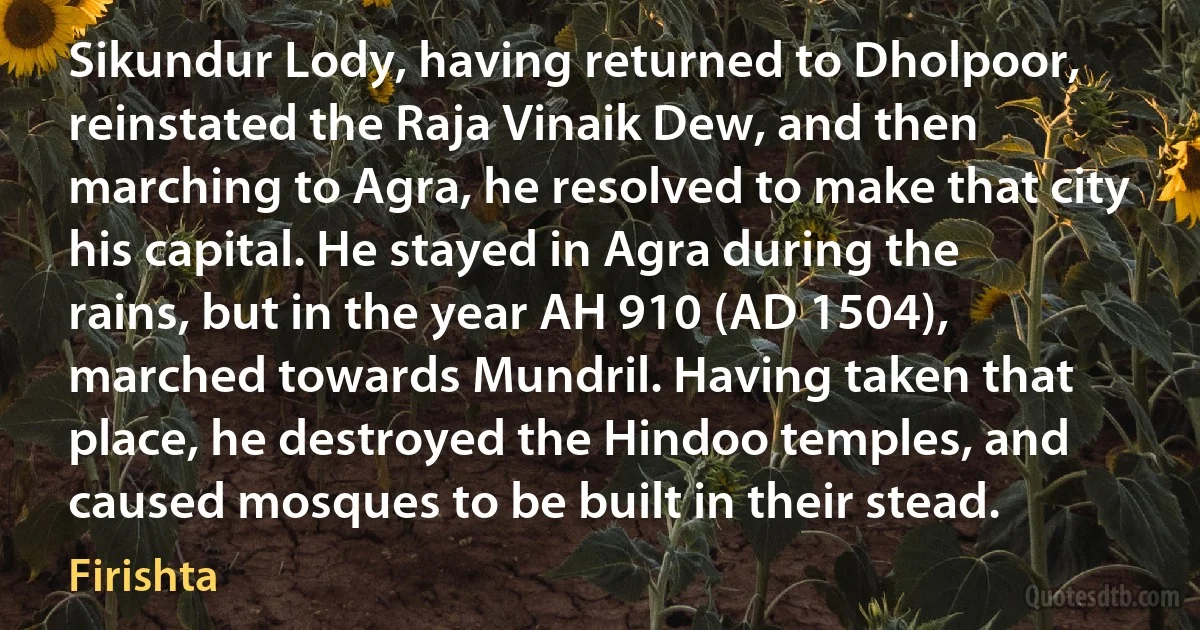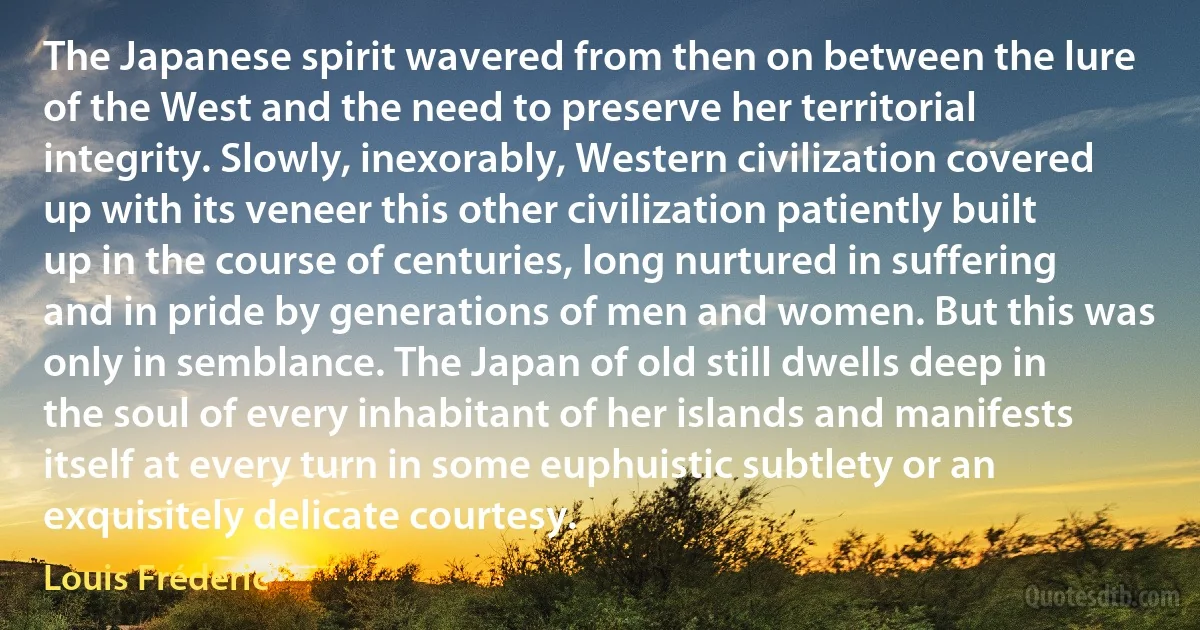Built Quotes - page 42
The transformation of the automobile market was essentially complete in 1929. If Mr. Ford, in that pivotal year in the modern economy, still held stubbornly to his old concept in his new Model A, he was counterbalanced by Mr. Chrysler, who had come up from nowhere with tremendous vitality and with a market policy similar to General Motors'. The fact that Mr. Ford built nearly two million of the five million U. S.-produced cars and trucks sold that year was only incidental from the long-term point of view. it was a splurge, not the sign of a trend.

Alfred P. Sloan
Sultãn Fîrûz Shãh composed a book also in which he compiled an account of his reign and which he named Futuhãt-i-Fîrûz Shãhî..."He writes in its second chapter... ‘Muslim and infidel women used to visit sepulchres and temples, which led to many evils. I stopped it. I got mosques built in place of temples'...

Firuz Shah Tughlaq
In the year AH 710 (AD 1310), the King again sent Mullik Kafoor and Khwaja Hajy with a great army, to reduce Dwara Sumoodra and Maabir in the Deccan, where he heard there were temples very rich in gold and jewels' They found in the temple prodigious spoils, such as idols of gold, adorned with precious stones, and other rich effects, consecrated to Hindoo worship. On the sea-coast the conqueror built a small mosque, and ordered prayers to be read according to the Mahomedan faith, and the Khootba to be pronounced in the name of Allaood-Deen Khiljy. This mosque remains entire in our days at Sett Bund Rameswur, for the infidels, esteeming it a house consecrated to God, would not destroy it.

Alauddin Khalji
The next matter which by God's help I accomplished, was the repetition of names and titles of former sovereigns which had been omitted from the prayers of Sabbaths and Feasts. The names of those sovereigns of Islam, under whose happy fortune and favour infidel countries had been conquered, whose banners had waved over many a land, under whom idol-temples had been demolished, and mosques and pulpits built and exalted, the fragrant creed had been extended, and the people of Islam had waxen strong and warlike, the names of these men had fallen into neglect and oblivion. So I decreed that according to established custom their names and titles should be rehearsed in the khutba and aspirations offered for the remission of their sins.

Firuz Shah Tughlaq
When Raja Sidhraj Jaisingh Solanki became the king, he extended his conquest as far as Malwa and Burhanpur etc. and laid foundation of lofty forts such as the forts of Broach and Dabhoi etc. He dug the tank of Sahastraling in Pattan, many others in Biramgam and at most places in Sorath. His reign is known as 'Sang Bast', the Age of Stone Buildings. He founded the city of Sidhpur and built the famous Rudramal Temple. It is related that when he intended to build Rudramal, he summoned astrologers to elect an auspicious hour for it. The astrologers said to him that some harm through heavenly revolution is presaged from Alauddin when his turn comes to the Saltanat of Dihli. The Raja relied on the statement of astrologers and entered into a pledge and pact with the said Sultan. The Sultan had said. 'If I do not destroy it under terms of the pact, yet I will leave some religious vestiges.

Alauddin Khalji
It's a book about the history of the Hindus, from 50 million B. C. E. to the present. It says that there is no evidence that Rama was born in the place that is now known as Ayodhya and there is no evidence that there was a Hindu temple on the spot where the Babur Mosque was. And that there is no evidence that Rama and a bunch of monkeys built a bridge from India to Sri Lanka, as the Hindu Right have claimed. That's just mythology, which is lovely, I've studied it all my life, but you don't legislate on the basis of mythology.

Wendy Doniger
...In the following year AH 804 (AD 1402), he marched to Somnat, and after a bloody action, in which the Mahomedans were victorious, the Ray fled to Diu. Moozuffur Shah having arrived before Diu laid siege to it, but it opened its gates without offering resistance. The garrison was, however, nearly all cut to pieces, while the Ray, with the rest of the members of his court, were trod to death by elephants. One large temple in the town was razed to the ground, and a mosque built on its site; after which, leaving his own troops in the place, Moozuffur Shah returned to Puttun.

Firishta
"...Ally Adil Shah, at the persuasions of his minister, carried his arms against Bunkapoor. This place was the principal residence of Velapa Ray, who had been originally a principal attendant of Ramraj; after whose death he assumed independence... "...Velapa Ray, despairing of relief, at length sent offers for surrendering the fort to the King, on condition of being allowed to march away with his family and effects, which Ally Adil Shah thought proper to grant, and the place was evacuated accordingly. The King ordered a superb temple within it to be destroyed, and he himself laid the first stone of a mosque, which was built on the foundation, offering up prayers for his victory. Moostufa Khan acquired great credit for his conduct, and was honoured with a royal dress, and had many towns and districts of the conquered country conferred upon him in jageer...245.

Firishta
Having returned to Agra, the King proceeded in the year AH 912 (AD 1506) towards the fort of Hunwuntgur, despairing of reducing Gualiar. Hunwuntgur fell in a short time, and the Rajpoot garrison was put to the sword, the temples were destroyed, and mosques ordered to be built in their stead...

Firishta
...On the return of Moozuffur Khan to Guzerat, he learnt that in the western Puttun district the Ray of Jehrend, an idolater, refused allegiance to the Mahomedan authority. To this place Moozuffur Khan accordingly marched, and exacted tribute. He then proceeded to Somnat, where having destroyed all the Hindoo temples which he found standing, he built mosques in their stead; and leaving learned men for the propagation of the faith, and his own officers to govern the country, returned to Puttun in the year AH 798 (AD 1395).

Firishta
...He was firmly attached to the Mahomedan religion, and made a point of destroying all Hindoo temples. In the city of Mutra he caused musjids and bazars to be built opposite the bathing-stairs leading to the river and ordered that no Hindoos should be allowed to bathe there. He forbade the barbers to shave the beards and beads of the inhabitants, in order to prevent the Hindoos following their usual practices at such pilgrimages...

Firishta
Mujahid Shah, on this occasion, repaired mosques which had been built by the officers of Alla-ood-Deen Khiljy. He broke down many temples of the idolaters, and laid waste the country; after which he hastened to Beejanuggur... The King drove them before him, and gained the bank of a piece of water, which alone divided him from the citadel, where in the Ray resided. Near this spot was an eminence, on which stood a temple, covered with plates of gold and silver, set with jewels: it was much venerated by the Hindoos, and called, in the language of the country, Puttuk. The King, considering its destruction a religious obligation ascended the hill, and having razed the edifice, became possessed of the precious metals and jewels therein.

Firishta
In the year AH 710 (AD 1310), the King again sent Mullik Kafoor and Khwaja Hajy with a great army, to reduce Dwara Sumoodra and Maabir in the Deccan, where he heard there were temples very rich in gold and jewels... They found in the temple prodigious spoils, such as idols of gold, adorned with precious stones, and other rich effects, consecrated to Hindoo worship. On the sea-coast the conqueror built a small mosque, and ordered prayers to be read according to the Mahomedan faith, and the Khootba to be pronounced in the name of Allaood-Deen Khiljy. This mosque remains entire in our days at Sett Bund Rameswur, for the infidels, esteeming it a house consecrated to God, would not destroy it.

Firishta
Working on GODZILLA RAIDS AGAIN was easier for me. The Godzilla costume that was built for the movie was made to fit me, whereas the one that had been built for GODZILLA - KING OF THE MONSTERS had not been made to fit me. The most difficult aspect of working on GODZILLA RAIDS AGAIN for me was shooting the ending. I had to stand in the middle of the set while a large amount of crushed ice came tumbling down on me.

Haruo Nakajima



